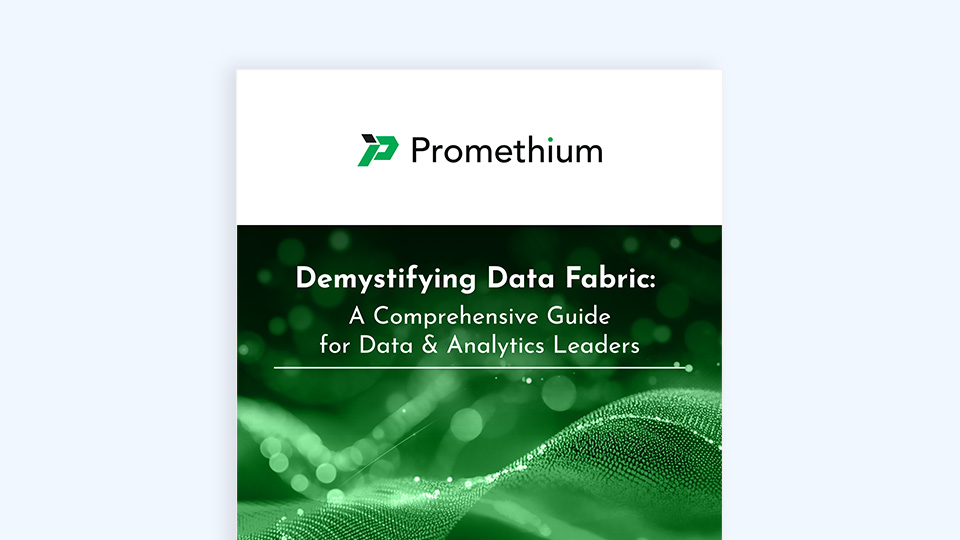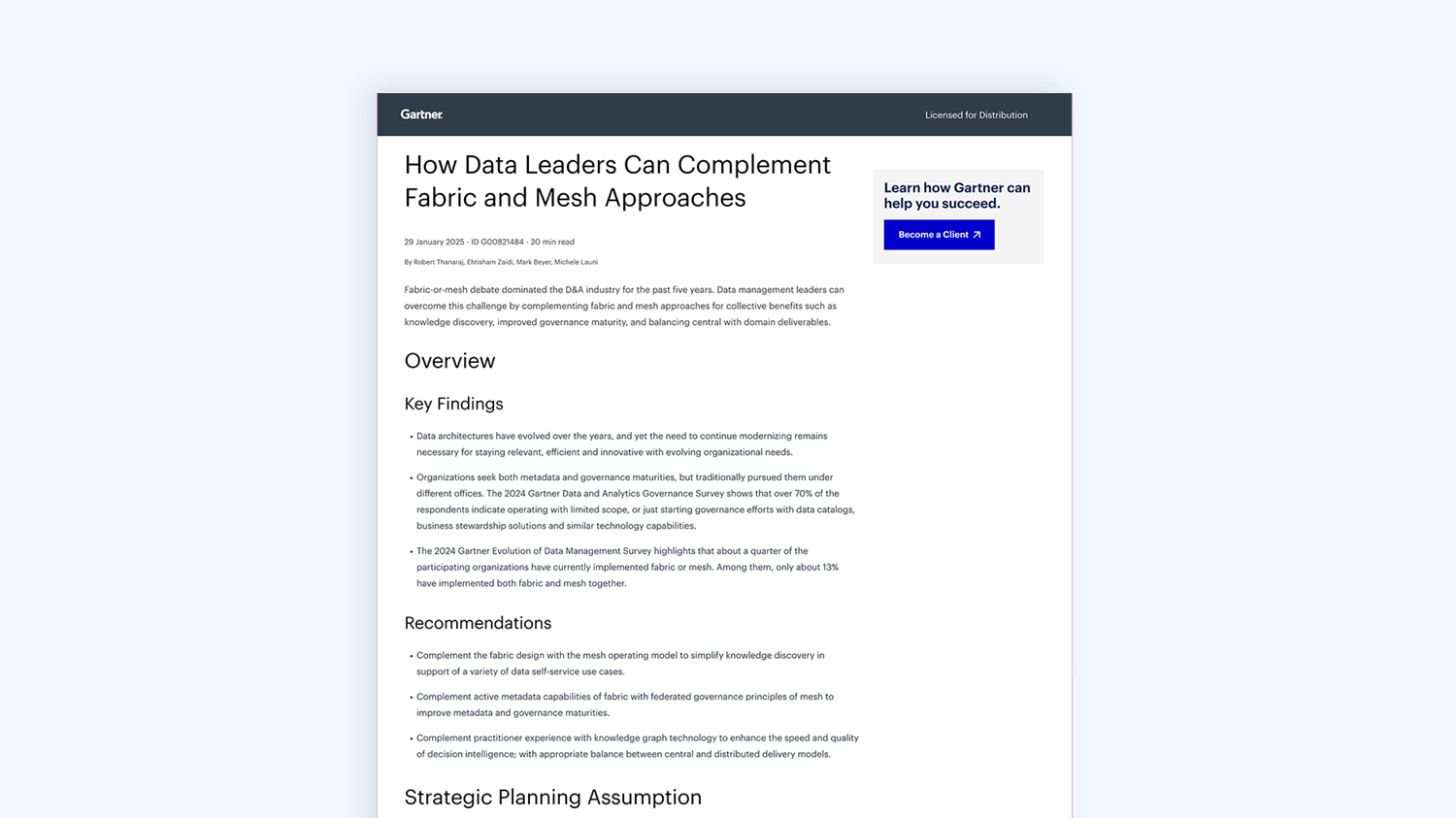Key Challenges in Energy & Utilities Data Management
Challenge 1: Fragmented Asset and Operational Data
Energy companies struggle with data silos across asset management systems, SCADA networks, maintenance databases, and operational control centers. Critical information needed for predictive maintenance, outage management, and operational optimization exists in separate systems, creating delays in issue resolution and inefficient resource allocation.
Challenge 2: Complex Customer Data and Billing Integration
Utility companies need unified views of customer usage, billing history, service interactions, and grid connectivity but data exists across meter management, customer information systems, and billing platforms. This fragmentation impacts customer service quality and prevents effective demand management and customer engagement programs.
Challenge 3: Smart Grid and IoT Data Integration
Modern energy operations generate massive volumes of real-time data from smart meters, sensors, and grid monitoring equipment. Integrating this streaming data with traditional operational systems for real-time analytics and decision-making requires complex infrastructure that traditional integration approaches struggle to handle effectively.
Challenge 4: Regulatory Compliance and Environmental Reporting
Energy companies face extensive regulatory requirements across federal, state, and environmental jurisdictions. Managing compliance data across operational systems, environmental monitoring, and financial reporting creates significant administrative overhead and regulatory risk.
Challenge 5: Asset Performance and Predictive Maintenance
Large energy companies operate complex infrastructure requiring predictive maintenance across generation, transmission, and distribution assets. Asset performance data exists across multiple maintenance systems, sensor networks, and historical databases, making it difficult to predict failures and optimize maintenance schedules.
Challenge 6: Customer 360 and Energy Management Programs
Utilities need comprehensive customer views across usage patterns, service history, program participation, and grid interactions to deliver effective energy efficiency programs and customer service. Customer data fragmentation prevents personalized service delivery and effective demand response programs.
How Data Fabric Transforms Energy & Utilities Operations
Instant Access to Operational and Customer Data
Query data across asset management, smart grid systems, customer platforms, and regulatory databases in real-time without migration or complex ETL processes. Get immediate answers to operational questions like “What’s our grid stability in high-demand areas with recent maintenance activity?” directly from your existing systems.
Utility-Ready Governance & Compliance
Built-in governance ensures regulatory compliance across all operational and environmental data sources simultaneously. Automated audit trails and access controls reduce compliance preparation time by up to 75% while maintaining adherence to energy regulations and environmental reporting requirements.
Conversational Data Access
Enable energy professionals to ask natural language questions like “Show me customers with high usage spikes and recent service calls in storm-affected areas” and get immediate, governed insights without technical training or SQL knowledge.
Zero-Copy Hybrid Architecture
Access data where it lives across cloud, on-premises, and hybrid environments without costly data movement or storage duplication. Seamlessly stitch together legacy operational systems with modern smart grid platforms while maintaining data integrity and operational security.
Enterprise-Scale Performance for Utility Workloads
Modern data fabric platforms are designed to handle the massive IoT and sensor data volumes common in energy operations through intelligent query optimization and distributed processing. Purpose-built for enterprise energy environments, instant data fabric delivers optimized performance even when querying millions of sensor readings and customer interactions across complex utility infrastructure.

Energy & Utilities Data Fabric Use Cases
Use Case 1: Predictive Asset Management and Maintenance
Challenge: Asset management teams need comprehensive equipment performance data across generation, transmission, and distribution systems but must access multiple maintenance and monitoring systems manually, creating delays in predictive maintenance and increased failure risk.
Solution: Instant access to unified asset data across all systems with conversational queries like “Show me transformers with declining performance metrics and upcoming maintenance schedules in high-priority areas.”
Results: 40% improvement in predictive maintenance accuracy, 30% reduction in unplanned outages, enhanced asset reliability and lifespan.
Use Case 2: Customer 360 and Energy Program Management
Challenge: Customer service and program management teams need comprehensive customer views across usage patterns, billing history, service interactions, and program participation but data exists across multiple customer systems.
Solution: Unified customer profiles combining usage, billing, service, and program data with analytics for personalized energy programs and improved customer service delivery.
Results: 35% improvement in customer satisfaction, 25% increase in energy program participation, enhanced customer retention and engagement.
Use Case 3: Real-Time Grid Operations and Outage Management
Challenge: Grid operations teams need immediate access to smart grid data, asset status, and customer impact information but traditional integration creates delays that impact outage response and grid stability.
Solution: Real-time federated queries across grid systems with automated dashboards for outage management, load balancing, and emergency response coordination.
Results: 50% faster outage response time, 25% improvement in grid stability, enhanced emergency preparedness and customer communication.
Use Case 4: Regulatory Reporting and Environmental Compliance
Challenge: Compliance teams spend weeks manually aggregating data from operational, environmental, and financial systems for regulatory filings and environmental reporting requirements.
Solution: Automated regulatory reporting with unified access to operational and environmental data for comprehensive compliance monitoring and filing preparation.
Results: 75% reduction in regulatory reporting preparation time, 90% reduction in compliance audit findings, enhanced environmental monitoring.
Use Case 5: Demand Forecasting and Energy Trading
Challenge: Energy trading and planning teams need comprehensive market data, demand patterns, and generation capacity information but lack unified views across trading platforms and operational systems for effective energy planning.
Solution: Unified access to trading, demand, and operational data with predictive analytics for energy market optimization and demand forecasting.
Results: 20% improvement in demand forecasting accuracy, 15% increase in trading efficiency, enhanced energy market positioning.
Energy & Utilities Data Fabric Vendor Landscape
Traditional Enterprise Platforms
IBM Cloud Pak for Data, Microsoft Fabric, Informatica
- Comprehensive capabilities but require 6-18 months implementation
- Complex deployment requiring specialized energy consulting teams
- High infrastructure and ongoing operational costs
Do-It-Yourself Custom Solutions
In-House Data Teams Building Custom Analytics
- Complete control over operational systems and data architecture
- Requires significant internal development resources and specialized energy expertise
- High ongoing maintenance burden with complex legacy system integration
- Limited scalability as smart grid and IoT data volumes grow exponentially
Instant Data Fabric Platforms
Promethium
- Conversational data access through natural language queries
- Zero-copy architecture with deployment in days, not months
- Built-in governance and compliance capabilities
- 360° context engine for trusted insights across operational and customer systems
- Empowers existing energy teams with self-service analytics
For a complete vendor analysis including detailed Palantir comparison, see our Data Fabric Vendor Comparison 2025.
Implementation Approach for Energy & Utilities
Energy Data Fabric Implementation Comparison
| Implementation Factor | Traditional Platforms | Do-It-Yourself Solutions | Instant Data Fabric (Promethium) |
| Deployment Time | 6-18 months | 18-48 months | Days to weeks |
| Implementation Cost | $3-12M+ infrastructure | $5-25M+ development | Transparent subscription |
| Team Requirements | Specialized consultants | Large engineering teams | Existing energy teams |
| Ongoing Dependencies | High IT maintenance | High internal maintenance | Self-service platform |
| User Training | Extensive technical training | Custom system training | Natural language interface |
| System Integration | Custom development | In-house development | Flexible energy connectors |
| IoT/Smart Grid Support | Additional development | Complex custom integration | Built-in IoT integration |
| Total Cost of Ownership | High + hidden costs | Very high + ongoing dev costs | Predictable subscription model |
Timeline Comparison:
Traditional/DIY Approach:
- Months 1-6: Infrastructure setup or engineering team hiring, system architecture design for operational systems
- Months 7-18: Data modeling, custom development, smart grid and customer system integration
- Months 19-24: User training, workflow integration, testing across operations and customer service
- Month 24+: Production use with ongoing maintenance and evolution challenges
Instant Data Fabric Timeline:
- Week 1: Platform setup and connection to asset management, customer, and operational systems
- Week 2: User onboarding for operations, customer service, and engineering teams
- Week 3+: Full production use with immediate operational and customer insights
Energy & Utility Success Metrics
Large utility and energy organizations implementing data fabrics typically see:
45%
improvement in operational team productivity and asset management efficiency
40%
faster outage response and customer service resolution
50%
reduction in regulatory reporting preparation time
30%
improvement in predictive maintenance accuracy
25%
increase in customer program participation and satisfaction

Compliance & Security for Energy & Utilities
Energy Industry Regulations
- Built-in compliance frameworks for FERC, NERC, and environmental reporting requirements
- Automated audit trails for utility regulatory examinations
- Real-time policy enforcement across all operational and customer data sources
- Support for cybersecurity frameworks and critical infrastructure protection
Energy Data Governance
- Role-based access controls aligned with utility organizational structure
- Data lineage tracking for regulatory and environmental reporting
- Centralized policy management across operational and customer systems
- Protection of sensitive customer and infrastructure information
Getting Started with Energy & Utilities Data Fabric
Evaluate Your Current State
- Audit existing energy systems and operational integration complexity
- Assess regulatory reporting burden and compliance gaps
- Identify high-value use cases like predictive maintenance or customer analytics
Pilot Implementation
- Start with asset management or customer data integration across 2-3 core systems
- Enable self-service access for operations and customer service teams
- Measure time-to-insight improvements and operational efficiency gains
Scale Across Operations
- Expand to smart grid, trading, and environmental systems
- Enable enterprise-wide self-service data access for energy data teams
- Integrate with external market data and regulatory feeds
Frequently Asked Questions
Data fabric enables operations teams to access comprehensive asset performance data across generation, transmission, and distribution systems from a single interface using natural language queries. Instead of manually checking multiple maintenance and monitoring systems, teams can ask questions like “Show me equipment with declining performance trends and upcoming maintenance windows” and get immediate, actionable insights for predictive maintenance.
Modern data fabric platforms provide unified customer views across usage patterns, billing history, service interactions, and program participation. This comprehensive approach to customer data significantly improves service delivery and enables more effective energy efficiency programs and demand response initiatives.
Yes, data fabric platforms are designed to connect with energy systems including SCADA networks, asset management platforms, customer information systems, and smart grid infrastructure through standard APIs and connectors, enabling immediate value without replacing existing operational or customer technology investments.
Data fabric enables compliance teams to access unified operational, environmental, and financial data through conversational queries. This accelerates regulatory filing preparation, improves environmental monitoring, and ensures comprehensive compliance across all regulatory requirements.
Instant data fabric platforms can be deployed and delivering value within days to weeks, compared to 6-18 months for traditional energy analytics platforms. Operations and customer service teams can start seeing productivity improvements in asset management and customer analytics immediately after deployment.
Learn More With Related Content & Resources
- Read the full data fabric explainer
- Compare data fabric vs data mesh
- Compare data fabric vs data virtualization
- Explore the full insights hubs


